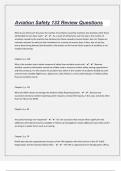Aviation Safety 133 Review Questions
Why do you think over the years the number of accidents caused by machines has declined, while those
attributable to man have risen? - ✔ ✔ As a result of refinements over the years, the number of
accidents caused by the machine has declined, but those caused by human factors has not. People are
naturally reluctant to admit to their limitations for a variety of reasons (loss of face, fear of job loss,
worry about being blamed) and therefore, information on the human factor aspects of accidents is not
readily forthcoming.
Chapter 6, p. 149
Why is the accident rate a better measure of safety than accident counts are? - ✔ ✔ Because
accident counts by themselves cannot be reliably used to measure relative safety among organizations
and their products. For this reason the accident rate, which is the number of accidents divided by some
common base variable (flight hours, departures, miles flown) is a more valid indicator of relative safety
than just accident counts.
Chapter 5, p. 111
Why was NASA chosen to manage the Aviation Safety Reporting System. - ✔ ✔ Because any
successful voluntary incident reporting system requires a trusted third party, in this case, someone other
than the FAA or the NTSB.
Chapter 4, p. 90
Are public hearings ever reopened? - ✔ ✔ On rare occasions they may be when significant new
additional information becomes available or follow-up investigation reveals additional issues that call for
an airing in a public forum such as a hearing
Chapter 3, p. 74
Briefly describe the organizational structure of the FAA together with the function of the Air Traffic
Organization and the Aviation Safety office. - ✔ ✔ The FAA is organized into 15 headquarters offices,
,nine field and regional offices, and two primary technical centers. Within that organization is the Air
Traffic Organization (ATO) which serves as the FAA operations branch in charge of en route and oceanic
services, system operations services, technical operations services, and terminal services. Aviation
Safety is another important FAA organization which encompasses a wide range of Agency functions and
responsibilities with many field offices such as the Office of Accident Investigation and Prevention, the
Office of Aerospace Medicine, and Air Traffic Oversight Service.
Chapter 2, p. 39-42
Compare and contrast the differences between a hazard and a safety risk. - ✔ ✔ Hazard = A
condition, object, or activity with the potential of causing injuries to personnel, damage to equipment,
or deduction of the ability to perform a prescribed function.
Risk = The assessment of the consequences of a hazard, taking as a reference the worst foreseeable
situation.
Chapter 12, p. 337
Define human error and explain the HFACS method used to classify human error. - ✔ ✔ HFACS is a
systems approach whereby human error is not the cause but rather the result of a larger problem inside
the organization. Four barrier levels exist to help prevent accidents:
- Organizational Influences
- Unsafe Supervision
- Preconditions for Unsafe Acts
- The Unsafe Act Itself (the active failure)
- I never felt like this answer was a slam dunk, but I couldn't find a better answer.
Chapter 7, p. 161
Describe how air traffic is controlled. - ✔ ✔ Air traffic controllers operate primarily from three types
of facilities: airport traffic control towers, terminal radar approach and control facilities, and air route
control centers, and in the process, control four categories of airspace: positive controlled airspace,
controlled airspace, uncontrolled airspace, and special use airspace.
, Chapter 8, p. 179
Describe some of the problems and improvements needed to gather better weather information. - ✔
✔ Real time "big picture" integrated display of weather, and airborn weather radar with vertical and
plan cross-sectional views.
Chapter 9, p. 235
Describe some technological improvements in the following stopping systems: antiskid, fuse plugs in the
wheels, engineered materials arrestor system, wing spoilers, thrust reversers. - ✔ ✔ More easily
answered by just looking at pages 204-205
Describe the airport surface operational environment. - ✔ ✔ A complex system of markings, lighting,
and signage coupled with layouts that vary by airport.
Chapter 10, p. 262
Describe the database system managed by the NTSB. - ✔ ✔ The NTSB is responsible for the Aviation
Incident/Accident Database which contains information on every known civil aviation accident in the
United States.
Chapter 4, p. 95
Describe the fundamental components and salient features of SMS - The Four Pillars. - ✔ ✔ 1) Safety
Policy - Senior management commitment to improve safety
2) Safety Risk Management - Determines the need for and adequacy of risk controls based on
assessment and acceptance of risk.
3) Safety Assurance - Evaluates the effectiveness of risk control.
4) Safety Promotion - Training, and communication to create a positive safety culture.
Chapter 12, p. 335
Describe the general trend in aviation accidents during the 1980's, 90's and 2000s. - ✔ ✔ 1980's - p.
124




